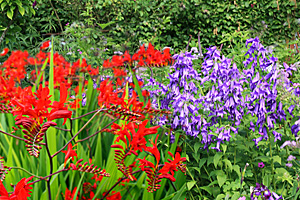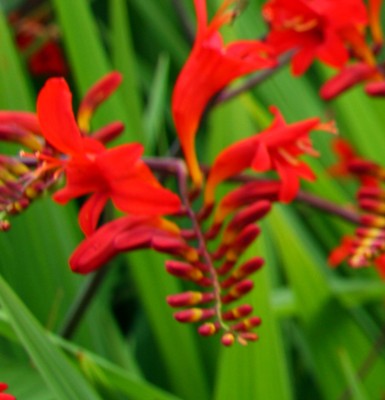 This tall combination makes a striking focal point in the back of the border during the summer. The violet blue of milky bellflower complements the scarlet red of ‘Lucifer’. The upward thrusting of the sword leaves of ‘Lucifer’ contrast with its own arching stems as well as the rounded heads of milky bellflower. This combination is best in the North because milky bellflower does not tolerate heat well, but in cool climates both plants like full sun and moist, well-drained soil.
This tall combination makes a striking focal point in the back of the border during the summer. The violet blue of milky bellflower complements the scarlet red of ‘Lucifer’. The upward thrusting of the sword leaves of ‘Lucifer’ contrast with its own arching stems as well as the rounded heads of milky bellflower. This combination is best in the North because milky bellflower does not tolerate heat well, but in cool climates both plants like full sun and moist, well-drained soil.
 Milky Bellflower (Campanula lactiflora var. coerulea)
Milky Bellflower (Campanula lactiflora var. coerulea)
This erect bushy bellflower is perennial and a native to the Caucasus. The violet-blue flowers are bell- shaped and borne in tight terminal clusters three to four inch long. The leaves are two to three inches long, sessile, and narrowly lanceolate. Milky Bellflower is happiest in the North where it can take full sun but can grow well in warmer climates if given partial shade. Plants do not transplant easily but readily self-sow. Spent flowers should be removed before seed set to encourage a second bloom in the fall.
-
Bloom Time: Summer (and again in fall with deadheading)
Size: 3-5’ H x 3’ W
Hardiness: Zones 5-7
 Montbretia (Crocosmia) ‘Lucifer’
Montbretia (Crocosmia) ‘Lucifer’
When Crocosmia and Curtonus paniculata were bred together the biogeneric ‘Lucifer’ was one of the exceptional results. The bight scarlet-red nodding flowers of ‘Lucifer’ are produced along slender arching stems opening from botton to top. When the flowers are spent and seeds are formed the stems bearing the seed pods look attractive through winter and are beautiful in dried bouquets. The long sword like leaves are produced in clumps and remain attractive throughout the growing season. Plants are perennial and grow from corms that may need to be lifted after the first frost in Zones 5 and colder.
-
Bloom Time: Summer
Size: 3-4’ H x 1’ W
Hardiness: Zones 5-9
